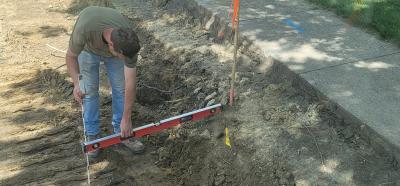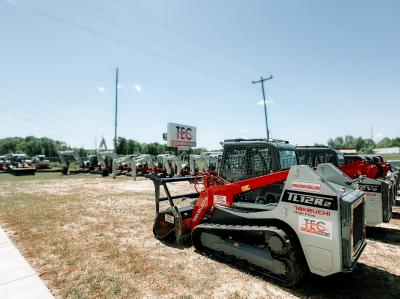A popular and well traveled Mississippi River bridge crossing through the southern regions of the states of Wisconsin and Minnesota recently opened and expanded traffic capacity and flow to the relief of interstate travelers and commuters.
Wisconsin Gov. Jim Doyle and local and state officials cut the ribbon in a mid-November ceremony to officially open and celebrate the new crossing after nearly two years of construction.
The 2,573 ft., $40 million bridge project will greatly increase vehicular volume and alleviate traffic back-ups and accidents in the area, according to Steve Flottmeyer, Wisconsin Department of Transportation (WisDOT) project engineer.
WisDOT managed the project and broke the bridge construction into three separate contracts. State officials awarded the first contract to Lunda Construction of Black River Falls, WI. Lunda constructed the substructure and retaining walls and hoisted the structural steel into place.
Deck, sidewalk, railing, lighting and parapet wall construction went to Zenith Tech Inc. of Waukesha, WI. James Cape & Sons constructed the approach roadway work, which included grading, storm sewer, paving, lighting and signal work.
For a project of this scale, Lunda used a total of eight Manitowoc, Terex and American cranes along with pile and vibratory hammers and a Samsung 450 backhoe.
Constructed along side the current bridge, “the new bridge will create a four lane crossing of USTH Highway 14/61 and STH 16 over the Mississippi River,” Flottmeyer said. “The new bridge will carry two lanes of eastbound traffic into La Crosse while the existing bridge will be converted to handle two lanes of westbound traffic over to Minnesota.”
The new bridge carries a two lane deck supported by ten spans of trapezoidal box beams and a 475 ft. (145 m) tied arch over the primary river channel.
Both bridges are one of only two river crossings of the Mississippi River in this region of the two states. The other crossing is located 5 mi. (8 km) north and carries traffic through the southern portions of Wisconsin and Minnesota along Interstate 90.
With 19,000 vehicles now crossing the bridge daily, slow traffic and backups have been an on-going nuisance in La Crosse.
“With that number projected to 28,000 ADT by 2024, this project will alleviate the traffic backups that currently exist and reduce the number of crashes in this area,” Flottmeyer explained.
The crash rate on this stretch of the highway has been considerably higher than the statewide average for many years and was also a primary concern for state engineers, Flottmeyer added.
Funding for the bridge work came from an 80/20 percent split in federal and state funds and a 75/25 percent split in federal and local funds for the road work.
Construction began on the new bridge in January 2003 with coffer dam work and the eventual concrete pouring for the 11 piers and subsequent deck construction.
Keeping the river channel open to boat and barge traffic dictated that the contractor take a unique approach by building the 475 ft. (145 m) long, 50 ft. (15 m) wide and 87 ft. (26.5 m) high arch offsite.
It would be eventually hoisted to three falsework towers, also constructed off site, and floated into place from its staging alongside the east river bank.
As the piers of the new bridge began rising from the river surface, ironworkers from High Boom Construction, based out of Black River Falls, WI, began piecing together the falsework towers on top of 3 barges about a mile upstream from the lead construction activity using Terex cranes.
Meanwhile, construction on the arch moved quickly. Workers at PDM steel plant in Eau Claire, WI, prefabricated sections of the arch at the plant and trucked them 150 mi. south to the site of the tower construction.
After ten weeks of construction, High Boom ironworkers completed the temporary support structure for the arch. At approximately 67 ft. (20 m) high, 60 ft. (18 m) wide, weighing 250 tons (225 t) and composed of 25 truck loads of steel and concrete, the structure was ready to carry its load.
Without a break in construction, Lunda barge pilots floated the three towers and prefabricated arch down river to the staging area a couple hundred yards away from the bridge. The barges, tied together by steel I-beams and anchored by spuds, created a floating platform for High Boom ironworkers catching the prefabricated arch sections from Lunda crane operators handling the controls below.
Held together with more than 28,000 field bolts, High Boom ironworkers hoisted the last piece of steel for the arch into place late in the fall of 2003.
“We did a lot of calculations to distribute the weight and there was some balancing that took place to keep things uniform and level out there,” Paul Nortman, project superintendent of Lunda Construction explained. “But it was very stable.”
The arch float garnered a lot of interest from the local media and in turn grabbed the attention of hundreds of curious spectators throughout the day.
With no ice on the river –– which Lunda workers were prepared to fight by running a boat up and down the channel –– and no wind, conditions for a successful float were excellent, Nortman noted.
The wind factor concerned state and Lunda engineers the most. With the whole structure acting like a giant sail, they did not want a southerly wind roaring up the river and pushing it toward the bridge.
“A northern wind would not have bothered the barge pilots as much because they would be pushing against it,” said Gary Snyder, WisDOT project leader of the bridge construction.
On the other hand, “with a southern wind, the barge pilots would have had a harder time in holding the whole structure back.”
To move the arch over its final resting place on the bearings on top of two piers looming above the river channel, the barge pilots pushed off parallel from the east river bank in the dark of a cold and early December morning and began making a slow, 90 degree turn toward the piers.
Three tug boats performed this maneuver; one on each of the two outside barges and one in the middle.
All three pilots and High Boom ironworkers were in constant radio communication. After several hours, the barge pilots had jockeyed the whole assembly in between the two river piers. After stabilizing the barges with winches to the bases of the two piers, it was time to lower the whole arch assembly into place.
For a project measured in thousands of feet, the final adjustments to placing the arch came down inches and tenths of a foot.
As the barge pilots began lowering the arch by taking in water to their ballast tanks, the bearings for the arch had to be adjusted less than half an inch. And, with the ballast tanks almost full, the arch still hovered above the bearings about one tenth of a foot.
The project superintendent called the nearest dam, 5 miles upstream, to request that the river be lowered slightly to allow the barge pilots more play with their ballast tank adjustments to set the arch in place.
“The weather was in our favor,” Nortman remarked. “We didn’t encounter any problems. Everything went better than planned.”
“We spent a lot of time putting the plan together and that really helped in executing it,” added Brady Frederick, steel erection project manager of Lunda.
With the arch firmly in place, Lunda and High Boom workers moved on to the next stage of construction in setting the trapezoidal box girders, some of them 145 ft. (44 m) long and weighing over 100 tons (90 t).
Terex and Manitowoc crane operators began hoisting the trapezoidal box girders in January of 2004 and set the last girder this past May. They hoisted in tandem and sometimes triplet the longer and heavier box girders.
The cranes, sitting on floating barges, all “worked very well,” Nortman noted, “with very little maintenance problems.”
In setting the trapezoidal box girders, the shape of the bridge and drop in elevation posed some geometrical challenges, Nortman said.
“There’s an ’S’ curve on the bridge so there were some unique geometry calculations that we did there” to maintain the alignment, Nortman explained.
And from the arch to the point the pavement hits the east abutment, “there’s a grade drop there so there were some challenges in making sure our grade lines matched up.”
The PDM plant in EauClaire, WI, also manufactured the trapezoidal box girders and trucked them more than 150 mi. to the construction site.
The concrete paving operation on the arch also featured a unique technique to place the concrete and was a first for this particular highway district, WisDOT officials said.
“In order to keep the weight of the concrete equally distributed on the central arch, two Bidwell Finish machines were used for the pour. Each one began at the middle of the arch and moved in opposite directions,” Nortman explained.
Corell Ready Mix from La Crosse trucked the concrete to Zenith Tech paving crews on the arch deck. Conveyer belts moved the concrete at each end of the arch to the Bidwell Finish machines and the crews operating them.
Bob Kohlenberg, project manager of Zenith Tech said the paving operation for the deck pour of the arch went “really well” with no problems and that the entire pour was completed in less than eight hours.
Once the Zenith Tech crews completed the deck paving for the arch in early October, the only remaining work to be done included the installation of the parapet walls, lighting and railings. Crews completed all work on the bridge to meet its November opening schedule.
With the bridge now open to the traveling public, motorists should see far fewer traffic back-ups and a safer, more uniform flow through this busy and popular Mississippi river crossing, WisDOT officials said.
Today's top stories















